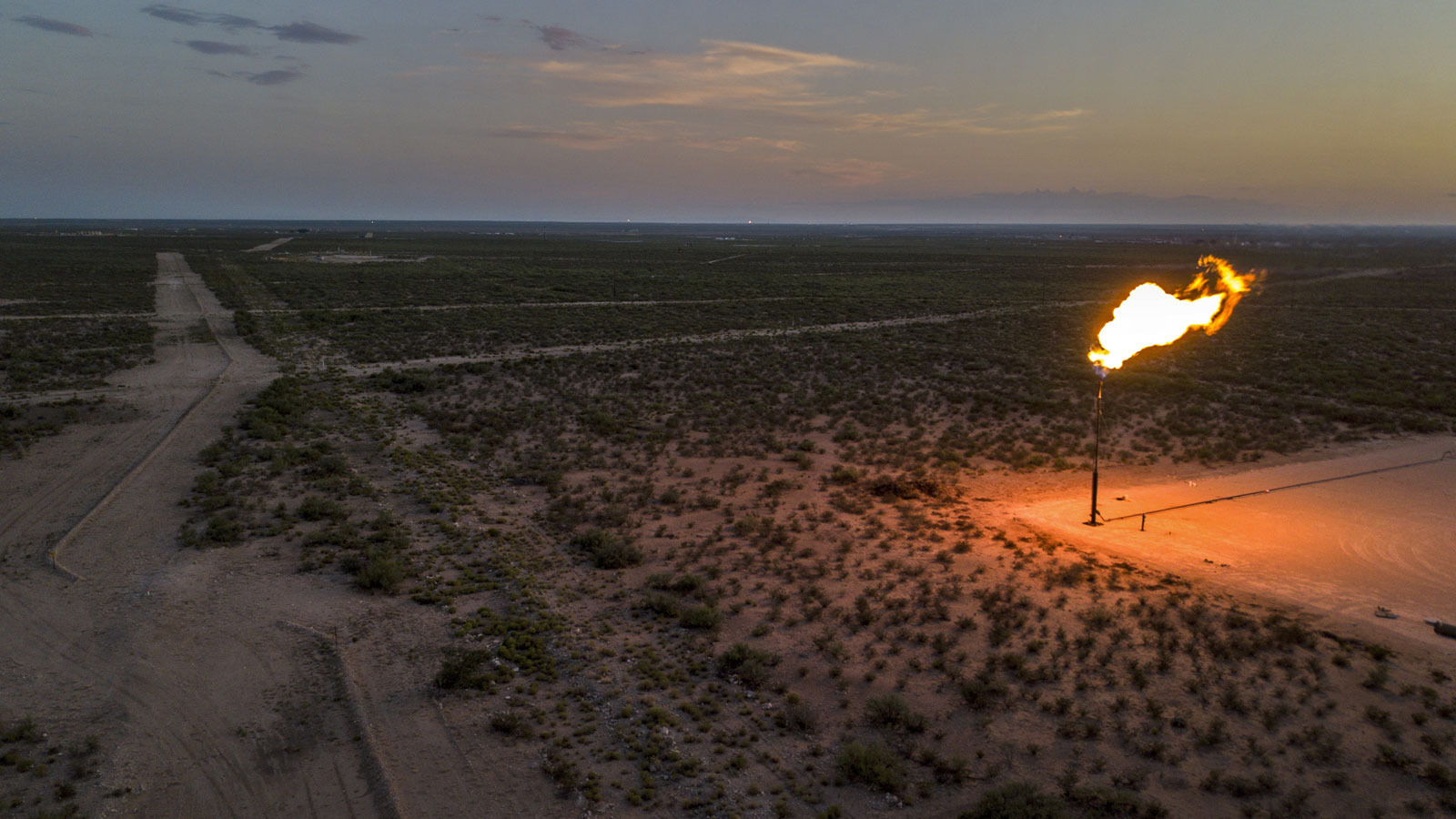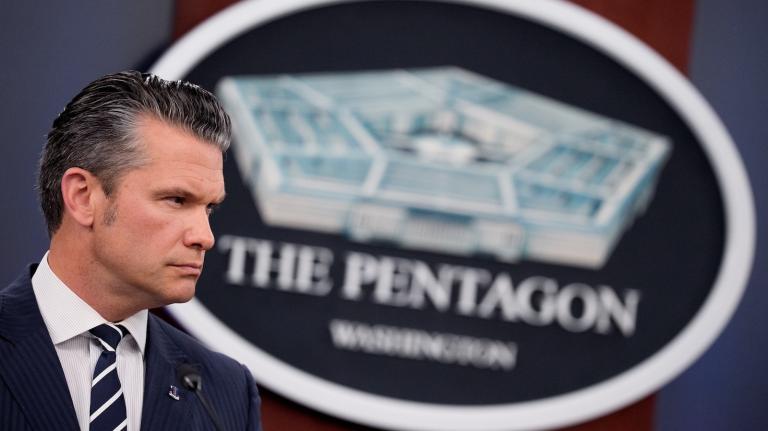Billions of cubic feet of natural gas are burned off in U.S. oil and gas fields every year, wasting the fossil fuel and emitting greenhouse gases without actually generating energy. In Texas alone, state regulators have permitted companies to burn more than a million cubic feet of gas every day since 2019. Combined, that would be enough natural gas to supply 15 million homes’ annual gas needs.
Fossil fuel companies choose to burn natural gas instead of capturing and selling it for a variety of safety and economic reasons. Most commonly, oil fields have a gas glut and insufficient pipeline capacity to move it to refineries and markets. The solution to the logjam is to burn excess natural gas — which is primarily composed of methane, a potent planet-warming pollutant — with the permission of state regulators.
The Texas Railroad Commission, or RRC, is the state agency tasked with regulating the oil and gas industry and overseeing companies’ flaring practices. When fossil fuel companies want to flare, they’re required to request a permit from the agency. But a new analysis by Earthworks, an environmental nonprofit, has found compelling evidence that they often don’t bother to. In fact, more than two-thirds of the 227 flares observed during three months in 2020 were not permitted by the state, according to the group, potentially leaving the RRC in the dark.
“They don’t know about the majority of flaring that goes on in Texas,” said Alan Septoff, a spokesperson for the nonprofit. “All of the state data that they’re basing their policy decisions on is bunk.”
When natural gas is burned during flaring, methane is converted to carbon dioxide that’s released into the atmosphere. But flares often don’t fully combust or are left unlit, which results in methane being vented directly into the air — an even more potent contribution to climate change. The Earthworks report counts both lit and unlit flares and adds to a growing body of evidence that methane emissions from oil and gas fields are vastly undercounted. It’s also the first analysis to identify what could constitute widespread illegal flaring in Texas oil fields.
Tim Doty, a former employee with the Texas Commission on Environmental Quality, or TCEQ, reviewed Earthworks’ analysis and told Grist that he “wasn’t particularly surprised” by the findings. As an investigator for the regulatory agency’s enforcement division until his retirement in 2018, he said it was common knowledge that there were a “lot of unregulated emissions” in oil fields. (While flaring permits are granted by the RRC, the TCEQ is responsible for overseeing air quality in the state and has jurisdiction over emissions from flares.)
“The system is really built on an honor system,” he said. “You hope the actual field activities are reflective of the paperwork.”
Methane is a uniquely strong contributor to climate change. Last week’s Intergovernmental Panel on Climate Change report identified methane as the second largest contributor to global warming after carbon dioxide. The gas is more potent than carbon dioxide, and the oil and gas industry is a significant source of the substance. Since methane emissions from flares are accompanied by black carbon when flares improperly combust gas, as well as toxic volatile organic compounds such as benzene, which is carcinogenic, flares are a more immediate public health concern in addition to a long-term climate menace.
Jack McDonald, a field analyst for Earthworks, primarily relied on two datasets to identify unpermitted flares in Texas. The first was provided by the Environmental Defense Fund, an environmental nonprofit that has been researching methane emissions from oil fields and finding that companies often underestimate how much gas they release into the atmosphere. This dataset documented flares observed by helicopter flyovers conducted by the Environmental Defense Fund in January, March, and June 2020. McDonald then obtained a second dataset of permitted flares from the RRC through a public records request. He compared the flares observed during the flyovers to the list of flares that were actually permitted by the state.
The findings were stark. In at least 69 percent of the cases, McDonald was unable to locate any permits for the observed flares. Almost 80 percent of flares that were surveyed twice by Environmental Defense Fund helicopters were found to be unpermitted on both occasions. In 36 cases where flares were surveyed three times, more than half were unpermitted on all three occasions. Among the worst offenders, according to the report, are Shell and ExxonMobil — companies that have made public commitments to reducing their methane emissions. None of the seven observed flares tied to Shell’s operations were permitted, according to McDonald. In Exxon’s case, just two of eight flares observed were permitted.
The agency’s emissions and flaring data “is likely inaccurate because the operators are not approaching them with permitting information,” said McDonald.
Andrew Keese, a spokesperson for the RRC, said that the flares identified by Earthworks may be exempt from regulation. State rules allow for emergency flaring for up to 24 hours and during the first 10 days after a well has been drilled, with no requirement to obtain permits or notify the state.
“A short-term observation of a flare from a flyover and absence of an explicit exception does not necessarily mean the observed flaring is illegal,” he said.
McDonald, the field analyst for Earthworks, said none of the observed flares were tied to wells that had been recently completed and also questioned whether operators were abusing the exemption for emergencies, rather than simply engaging in prolonged unpermitted flaring.
Spokespeople for both ExxonMobil and Shell denied that they flare without permits. Julie King, an ExxonMobil spokesperson, said the report is “inaccurate and deliberately misleading,” while Natalie Gunnell, a spokesperson for Shell, said that the company does not flare or vent natural gas without permits and that it is committed to reducing its methane intensity — a measure of emissions per unit of energy produced — to below 0.2 percent by 2025. Both King and Gunnell pointed out that not all flaring activities require permits. “Flyover operations are not able to differentiate between flaring or venting events that do or do not require [permits],” Gunnell said.
The Earthworks report calls on the RRC to better enforce flaring rules by hiring additional inspectors, increasing the number of inspections, raising penalties for violations, and prohibiting flaring permits for repeat offenders. If the agency fails to uphold state rules, the Texas legislature must step in, McDonald said.
“If the Commission’s not going to fix it, then the legislature could step in and fix it,” he said.
“I don’t think anyone believes the Railroad Commission is a good faith actor who is going to increase regulation on oil and gas companies without some outside fix.”
Update: This story originally contained a quotation from an Earthworks staffer who suggested that all flares without permits are illegal. The quotation has been removed for clarity.




